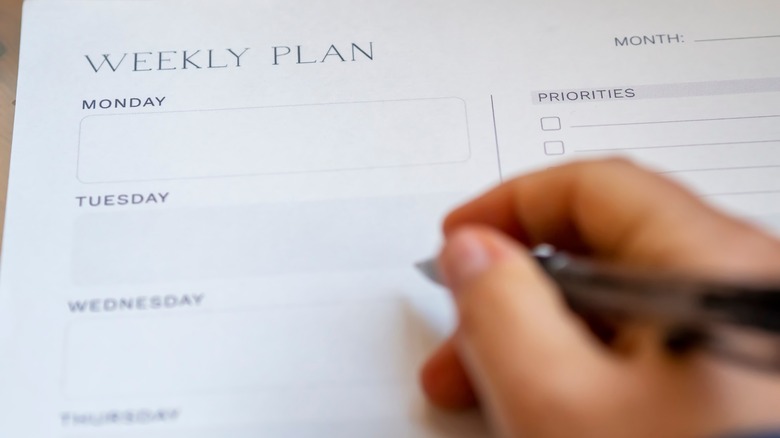What Is A Serendipity Journal And How Can It Change Your Spiritual Journey?
Journaling has gained a fair amount of traction within wellness communities recently, and it's no mystery why. Whether it's to heal your inner child, manifest through affirmations, do shadow work, or simply clear your mind through a stream of consciousness writing, putting pen to paper works wonders for the consciousness and psyche. You've also likely heard of gratitude journaling, but what about serendipity journaling?
Dictionary.com defines serendipity as "an aptitude for making desirable discoveries by accident," and a serendipity journal essentially allows us to track and examine moments of seemingly unexpected luck. The practice also helps us become more at ease with the unpredictability of life, and the tool helps us use the unexpected events life may send our way in our favor. Through serendipity journaling, we are cultivating a serendipity mindset — or preparing ourselves to become a landing space for blessings. Let's take a closer look at what exactly a serendipity journal looks like and how it can change your spiritual journey.
Relax into reflection
The first step in serendipity journaling — after choosing a fun, new journal, of course — is to review the past six months or so of your life. Think of three moments that were, without a doubt, serendipitous. Examine if there are any ties between these lucky happenings. This could look like running into a friend who told you about a job opening you took or stumbling across a flyer for an art show you ended up attending and meeting a new friend who impacted your life.
If you can't seem to think of anything, don't fret. Exercising the serendipity muscle is what this activity is all about. The more you pay attention to moments of synchronicity, the more often it will seem to happen. Write down these three moments in your journal and explore their relationship. Think back to how you felt in these lucky moments, and also note what you might have missed had you been distracted.
Examine your decisions
The next phase of a serendipity journal entry is to consider how your life would be different had you taken a different route in those fortunate moments. What would your path look like if you had picked up the art show flyer but opted to stay home that evening instead? Perhaps, you wouldn't have met your new friend, and, in hindsight, would that be positive or negative?
Or the friend you ran into who notified you of the job opening — had you not pursued the opportunity, would you be better or worse off? This is a chance to examine your tie to your intuition and when you choose to listen to it. Did you recognize the moment as fortunate, and did it work in your favor to listen? Or were you simply going with the flow? Notice which opportunities seemed to land in your lap and the ones you played an active role manifesting.
Review your hesitations
After reflecting on your recent encounters with serendipity, think back on some of those lucky moments you didn't follow up on. Perhaps you were too busy or unsure anything could come of it. Consider how you are feeling about the events now. Are the excitement and enthusiasm still there? Are you disappointed that you didn't follow through with the potential opportunity? Meditate on what arises for you.
If the energy is still there around the serendipitous event, can you still take action and explore the possibility? Chances are high that you can. And if not, this is still an important exercise. Now you'll know in the future to listen to the waves of serendipity that come into your life and to follow your enthusiasm for what sparks a light. It takes practice to work with intuition and read the secret language of serendipity, so be patient and keep trying.
Assess your priorities and daily routine
At this point in your journal entry, it's time to assess how you're managing your time in line with the goals and manifestations you'd like to come to fruition. Are you seeking deeper connections in your friendships but not reaching out very often? Or perhaps you'd like to publish a book, but the actual writing of the said book isn't happening very regularly. If someone were to watch how you spend a day, what would they say your priorities are?
This part of the process can cause us all to wince a bit — who really wants to examine how much time they spend scrolling? But it's important to do. What small steps could you implement to fill the form you aim to embody? Journaling can help bring this discrepancy into perspective and allow us to make shifts we might not really be able to see without putting our routine onto paper.
Explore experiences when you ignored serendipity
Next, you'll think of when inspiration — or serendipity — came through you, but you opted not to act. Maybe you love to paint, and a vision for a portrait popped into your mind as you mindlessly did the dishes. You decided not to attempt the picture for whatever reason; you felt tired, it seemed too complicated, or you didn't feel good enough.
Then, a few weeks later, you see a similar portrait on Instagram. And when you run through a cycle of emotions, maybe you feel envious or frustrated. Maybe you're kicking yourself for not taking action. Perhaps you slip into hopelessness, telling yourself you were right: You couldn't do it, and someone else did it better. Examine those feelings as neutrally as you can. If you regret not listening to your inspiration, chances are you'll step into active serendipity next time motivation strikes and sit down on the canvas.
Notice the subtle shifts
Once you've got the hang of serendipity journaling — aim for just a few minutes a day — you'll likely notice shifts in your awareness of the not-so-random occurrences in your daily life. It's a lot like the experience of buying a new car, and then suddenly you're seeing that model everywhere. Once something is in our consciousness, we're bound to experience it externally far more than previously. We may shift the tides so that what we share is more good fortune.
"A lot of times it's about where do we put our attention and how do we see— especially positively—unexpected things in life more often," Christian Busch, Ph.D., the author of The Serendipity Mindset: The Art & Science of Creating Good Luck, told My Imperfect Life. "But we don't do necessarily the same for the positive unexpected. A journal is a great way to focus our attention on it." These changes will help you notice subtle gifts and opportunities that otherwise would've been missed completely.
Implementing serendipity into your wellness routine
You don't have to replace your current gratitude or manifestation journaling practice with serendipity journaling; they certainly tie into one another and can be quite complementary. If you've been practicing gratitude for a while now, you've likely already tapped into the part of your awareness that keeps an eye out for things, people, and experiences to be grateful for. As you get further into serendipity journaling, you will notice more and more synchronistic events in your life.
These spiritual practices can round out your wellness journey and bring you a deeper sense of wholeness and fulfillment. Don't overload your spiritual to-do list; feel what's working for you and nurture that skill. It'll take a bit of self-discipline, as it always does, to implement a new habit, but the results should be well worth it. And once you're working with serendipity to actively bring your desires into your life, you'll see why intention and consistency were crucial to the practice.







